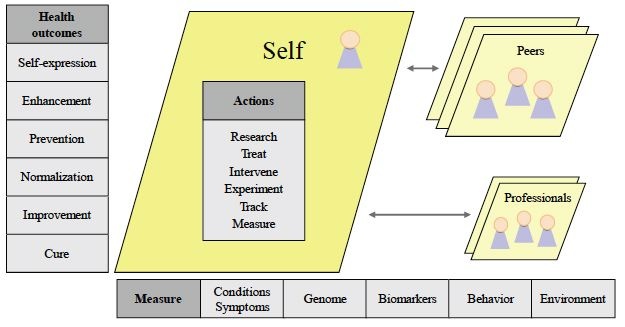Consumer health informatics
Consumer health informatics (CHI) is a branch of health informatics (also known as "medical informatics") that focuses on "consumer interests and is about providing the consumer with the right tools, skills, support and knowledge to better manage their healthcare."[1] The primary difference between health informatics and CHI isn't so much the technology as it is whose use it serves: health informatics applications typically focus on the healthcare provider while CHI applications focus on the patient or health care customer.
History
The terminology of "consumer health informatics" likely came about in July 1993 during a conference in Wisconsin for consumer health IT developers. Organized by Tom Ferguson, Don Kemper, and Bill Hettler, the conference — "Consumer Health Informatics: Bringing the Patient into the Loop" — used the term in the name, brochure, and proceedings.[2] However, the seeds for the term originated out of the consumerism of the 1980s, which prompted patients to more proactively participate in their own healthcare and disease management.[1][3] As the Internet and Web 1.0 evolved in the mid- to late 1990s, static websites like HealthInsite.com[4] appeared promoting healthcare and providing prevention schemes to consumers. Despite its promise, researchers still lamented several problems with the process, including low health literacy, limited Internet access, limited relevant high-quality information, poorly organized information, and the continued prevalence of traditional consumer-provider interactions.[5]
As Web 2.0 arrived in late 2004, a richer user experience with more dynamic, scalable content was provided to web users seeking health information.[1] Also during this time consumers' desire to more readily access an integrated health profile drove the further development of the electronic health record[3] and the personal health record, a healthcare portal offered by a health care professional that often synchronizes to the EHR.[1]
Informatics
Online-accessible personal health records, credential-backed health forums, and patient- and doctor-to-patient social networks are a few examples of consumer health informatics tools.[1][6]
External links
- Center for Consumer Health Informatics Research (CCHIR)
- Consumer Health Informatics Research resource (CHIRr)
- HealthIT.gov
References
- ↑ 1.0 1.1 1.2 1.3 1.4 Ho, Jessica; Hovenga, Evelyn J. S. (ed.) (2011). "Chapter 15: Consumer health informatics". Health Informatics: An Overview. IOS Press. pp. 185–194. ISBN 9781607500926. http://books.google.com/books?id=eckD3fSrPagC&pg=PA185. Retrieved 06 June 2014.
- ↑ Ferguson, Tom. "Doctom's FAQ: What is Consumer Health Informatics?". Tom Ferguson. http://www.fergusonreport.com/articles/tfr07-03.htm. Retrieved 06 June 2014.
- ↑ 3.0 3.1 Brennan, Patricia Flatley; Starren, Justin B.; Shortliffe, Edward H. (ed.); Cimino, James J. (ed.) (2006). "Chapter 14: Consumer Health Informatics and Telehealth". Biomedical Informatics: Computer Applications in Health Care and Biomedicine. Springer. pp. 511–536. ISBN 9780387362786. http://books.google.com/books?id=Wn-fFVuUguMC&pg=PA511. Retrieved 06 June 2014.
- ↑ "HealthInsite". Office of the National Health & Medical Research Council. Archived from the original on 17 August 2000. https://web.archive.org/web/20000817030602/http://www.healthinsite.com/. Retrieved 06 June 2014.
- ↑ Eysenbach, Gunther; Jadad, Alejandro R. (2001). "Evidence-based Patient Choice and Consumer health informatics in the Internet age". Journal of Medical Internet Research 3 (2): e19. doi:10.2196/jmir.3.2.e19. http://www.jmir.org/2001/2/e19/. Retrieved 06 June 2014.
- ↑ Bradley, Ryan (12 April 2013). "Social Media Comes to Health Care". TechTelling Online. http://techtelling.com/2013/04/12/social-media-comes-to-health-care/. Retrieved 06 June 2014.










